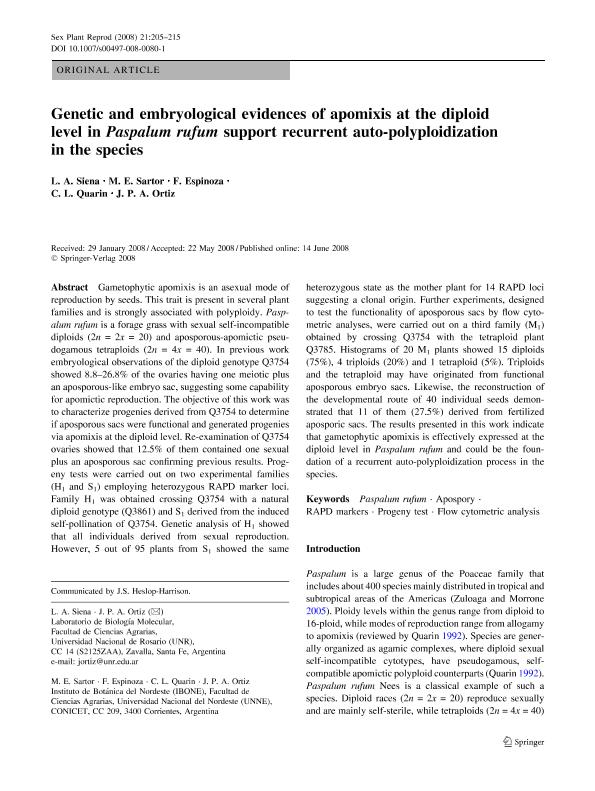Mostrar el registro sencillo del ítem
dc.contributor.author
Siena, Lorena Adelina

dc.contributor.author
Sartor, Maria Esperanza

dc.contributor.author
Espinoza, Francisco

dc.contributor.author
Quarin, Camilo Luis

dc.contributor.author
Ortiz, Juan Pablo Amelio

dc.date.available
2018-02-16T18:06:48Z
dc.date.issued
2008-09
dc.identifier.citation
Siena, Lorena Adelina; Sartor, Maria Esperanza; Espinoza, Francisco; Quarin, Camilo Luis; Ortiz, Juan Pablo Amelio; Genetic and embryological evidences of apomixis at the diploid level in Paspalum rufum support recurrent auto-polyploidization in the species; Springer; Sexual Plant Reproduction; 21; 3; 9-2008; 205-215
dc.identifier.issn
0934-0882
dc.identifier.uri
http://hdl.handle.net/11336/36636
dc.description.abstract
Gametophytic apomixis is an asexual mode of reproduction by seeds. This trait is present in several plant families and is strongly associated with polyploidy. Paspalum rufum is a forage grass with sexual self-incompatible diploids (2n = 2x = 20) and aposporous-apomictic pseudogamous tetraploids (2n = 4x = 40). In previous work embryological observations of the diploid genotype Q3754 showed 8.8-26.8% of the ovaries having one meiotic plus an aposporous-like embryo sac, suggesting some capability for apomictic reproduction. The objective of this work was to characterize progenies derived from Q3754 to determine if aposporous sacs were functional and generated progenies via apomixis at the diploid level. Re-examination of Q3754 ovaries showed that 12.5% of them contained one sexual plus an aposporous sac confirming previous results. Progeny tests were carried out on two experimental families (H 1 and S1) employing heterozygous RAPD marker loci. Family H1 was obtained crossing Q3754 with a natural diploid genotype (Q3861) and S1 derived from the induced self-pollination of Q3754. Genetic analysis of H1 showed that all individuals derived from sexual reproduction. However, 5 out of 95 plants from S1 showed the same heterozygous state as the mother plant for 14 RAPD loci suggesting a clonal origin. Further experiments, designed to test the functionality of aposporous sacs by flow cytometric analyses, were carried out on a third family (M 1) obtained by crossing Q3754 with the tetraploid plant Q3785. Histograms of 20 M1 plants showed 15 diploids (75%), 4 triploids (20%) and 1 tetraploid (5%). Triploids and the tetraploid may have originated from functional aposporous embryo sacs. Likewise, the reconstruction of the developmental route of 40 individual seeds demonstrated that 11 of them (27.5%) derived from fertilized aposporic sacs. The results presented in this work indicate that gametophytic apomixis is effectively expressed at the diploid level in Paspalum rufum and could be the foundation of a recurrent auto-polyploidization process in the species.
dc.format
application/pdf
dc.language.iso
eng
dc.publisher
Springer

dc.rights
info:eu-repo/semantics/openAccess
dc.rights.uri
https://creativecommons.org/licenses/by-nc-sa/2.5/ar/
dc.subject
Apospory
dc.subject
Flow Cytometric Analysis
dc.subject
Paspalum Rufum
dc.subject
Progeny Test
dc.subject
Rapd Markers
dc.subject.classification
Agricultura

dc.subject.classification
Agricultura, Silvicultura y Pesca

dc.subject.classification
CIENCIAS AGRÍCOLAS

dc.title
Genetic and embryological evidences of apomixis at the diploid level in Paspalum rufum support recurrent auto-polyploidization in the species
dc.type
info:eu-repo/semantics/article
dc.type
info:ar-repo/semantics/artículo
dc.type
info:eu-repo/semantics/publishedVersion
dc.date.updated
2017-12-19T18:30:09Z
dc.identifier.eissn
2194-7961
dc.journal.volume
21
dc.journal.number
3
dc.journal.pagination
205-215
dc.journal.pais
Alemania

dc.journal.ciudad
Heidelberg
dc.description.fil
Fil: Siena, Lorena Adelina. Universidad Nacional de Rosario; Argentina
dc.description.fil
Fil: Sartor, Maria Esperanza. Consejo Nacional de Investigaciones Científicas y Técnicas. Centro Científico Tecnológico Conicet - Nordeste. Instituto de Botánica del Nordeste. Universidad Nacional del Nordeste. Facultad de Ciencias Agrarias. Instituto de Botánica del Nordeste; Argentina
dc.description.fil
Fil: Espinoza, Francisco. Consejo Nacional de Investigaciones Científicas y Técnicas. Centro Científico Tecnológico Conicet - Nordeste. Instituto de Botánica del Nordeste. Universidad Nacional del Nordeste. Facultad de Ciencias Agrarias. Instituto de Botánica del Nordeste; Argentina
dc.description.fil
Fil: Quarin, Camilo Luis. Consejo Nacional de Investigaciones Científicas y Técnicas. Centro Científico Tecnológico Conicet - Nordeste. Instituto de Botánica del Nordeste. Universidad Nacional del Nordeste. Facultad de Ciencias Agrarias. Instituto de Botánica del Nordeste; Argentina
dc.description.fil
Fil: Ortiz, Juan Pablo Amelio. Universidad Nacional de Rosario; Argentina. Consejo Nacional de Investigaciones Científicas y Técnicas. Centro Científico Tecnológico Conicet - Nordeste. Instituto de Botánica del Nordeste. Universidad Nacional del Nordeste. Facultad de Ciencias Agrarias. Instituto de Botánica del Nordeste; Argentina
dc.journal.title
Sexual Plant Reproduction

dc.relation.alternativeid
info:eu-repo/semantics/altIdentifier/doi/http://dx.doi.org/10.1007/s00497-008-0080-1
dc.relation.alternativeid
info:eu-repo/semantics/altIdentifier/url/https://link.springer.com/article/10.1007%2Fs00497-008-0080-1
Archivos asociados
